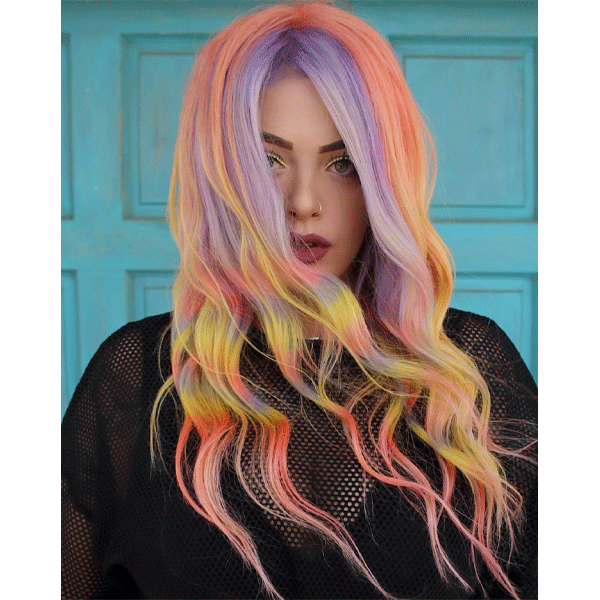3 Things To Know Before Buying Wigs
Looking For The Perfect Wig? Read This!
Have a client that wants to switch up their style, but not commit to a full transformation? Offering customizable wigs can allow your clients to express themselves and also boost your creativity (a little extra cash doesn’t hurt either!) If you haven’t checked Kimberly Ibbotson aka @kimberlytayhair on Instagram, you definitely should! She is the queen of creating custom, creative colored wigs. To get you started, we had Kimberly stop by The BTC House to break down everything you need to know about choosing quality wigs. Scroll down for everything and click here to purchase Kimberly’s class on BTC University to learn her creative color techniques for wigs!
What To Look For When Purchasing A Wig

For Kimberly, the three most important features when choosing a wig are:
- Density of the hair.
- The construction of the wig.
- The overall quality of the wig. Specifically, if the hair is synthetic or human. “The goal is to not be able to tell it’s a wig,“ Kimberly explains. Investing in a high-quality wig, especially if you’re looking to color it, will give the best results.
Quality Wigs = Endless Content
What’s the best part of having healthy wigs on deck? THE CONTENT. “My favorite thing about wearing wigs is that they are endless content,” Kimberly explains. You read that right: ENDLESS CONTENT!! “You can seriously create so many different looks with one wig,” Kimberly adds, that’s what makes caring for them so important.
Synthetic Hair vs. Human Hair
First, let’s break down the difference between synthetic and human hair wigs.
Synthetic Wigs: The “hair” is made from plastic fibers that resemble real hair, but don’t have the same feel as human hair would. Synthetic wigs are usually ready to be worn straight out of the box and require little to no styling, but they lack versatility when you want to change up the look.
Human Hair: Made from real human hair, the look and feel is more natural and can be styled and colored using techniques that are used in the salon. Human hair wigs do require more care than synthetic wigs, so we broke down how to store, wash and care for wigs below!
The Fuller The Wig, The More Natural The Look

When choosing a wig, choosing the right density will help the outcome of the style. The density measures the thickness of the hair, resulting in how full the wig will look. Typically, Kimberly uses three different types of densities:
- 130% Density, which is considered medium density.
- 150% Density, considered medium/ full density.
- 180% Density, considered full. Full density is Kimberly’s go-to when working with wigs longer than 12 inches. Why? “Wigs tend to become thinner towards the ends, so choosing a higher density will help alleviate any thinness, especially if you want to cut the wig,” Kimberly explains. “Plus,” she adds, “the higher the density of the wig the more natural the hair will look and feel.”
Choosing the Right Construction
Here, we break down the difference of the three common types of wigs to choose from.
- Full Weft: This type of wig is constructed from strips of hair sewn in the same direction across the head. Weft wigs tends to look the least natural because the hair falls in the same direction and cannot be manipulated without exposure.
- Lace Front: Hair is sewn into lace in the front or fringe area, with wefts of hair throughout the rest of the head.
- Full Lace: The most naturally looking wig, hair is sewn into lace all the way around the head. The lace can easily hidden by trimming off the excess and the hair can be styled multiple ways without exposure.
BONUS!! Proper At-Home Care Will Give Wigs Longer Wearability

“Think of caring for your wig the same way you would care for extensions,” Kimberly advises. The proper care will allow the wig to last longer and be more versatile when styling.
Storing Wigs
Proper storage will help wigs last longer. Kimberly suggests storing wigs on a mannequin head, a wig stand or in a silk bag. Try not to bunch wigs up and always brush them out to keep the strands of hair healthy.
Think Gentle When Washing Wigs
Washing a wig goes hand in hand with storage. Proper storage will minimize the need to wash wigs often. Wigs tend to shed more than natural hair, so over-washing will thin them out faster.
If the wig is a lace front or full lace wig, gently cleanse with a mild shampoo and warm water to remove any wig glue. Kimberly likes to use a soft bristled brush or toothbrush to make sure all of the glue is removed. If the wig is not washed properly, the glue can build up and become hard.
How often a wig should be washed really depends on how much it is worn. Kimberly broke it down like this, if you are wearing a wig once a weekend and go easy on the product, then washing once a month is just fine. However, if you are constantly changing the style and applying product to the wig, then wash it before every style session.
Click To See Kimberly At The BTC House!
Want to know how Kimberly achieves creative color on wigs? Click here for all of her wig coloring techniques and have lifetime access!








